Event ROI: How to Measure & Maximize The Impact of Your Events
“If it don’t make dollars, then it don’t make sense.”
The immortal words of DJ Quik could just as easily be the theme song for a modern marketer.
From ads to content to events, marketers are under more pressure than ever to not just execute, but to deliver ROI on every tactic and channel.
But we live in a complex world. So it’s no wonder that 85% or marketers say they have difficulty creating a single source of truth for marketing attribution.
Measuring event ROI can be particularly tricky.
Virtual, hybrid, and in-person events offer a powerful way for brands to increase exposure and build meaningful connections with their audiences. They can help improve brand image, boost customer retention, and drive conversions.
From an ROI perspective, you’re often trying to connect offline and online activity in order to properly attribute value. And events can generate both short and long-term ROI like increased retention, loyalty, and referrals.
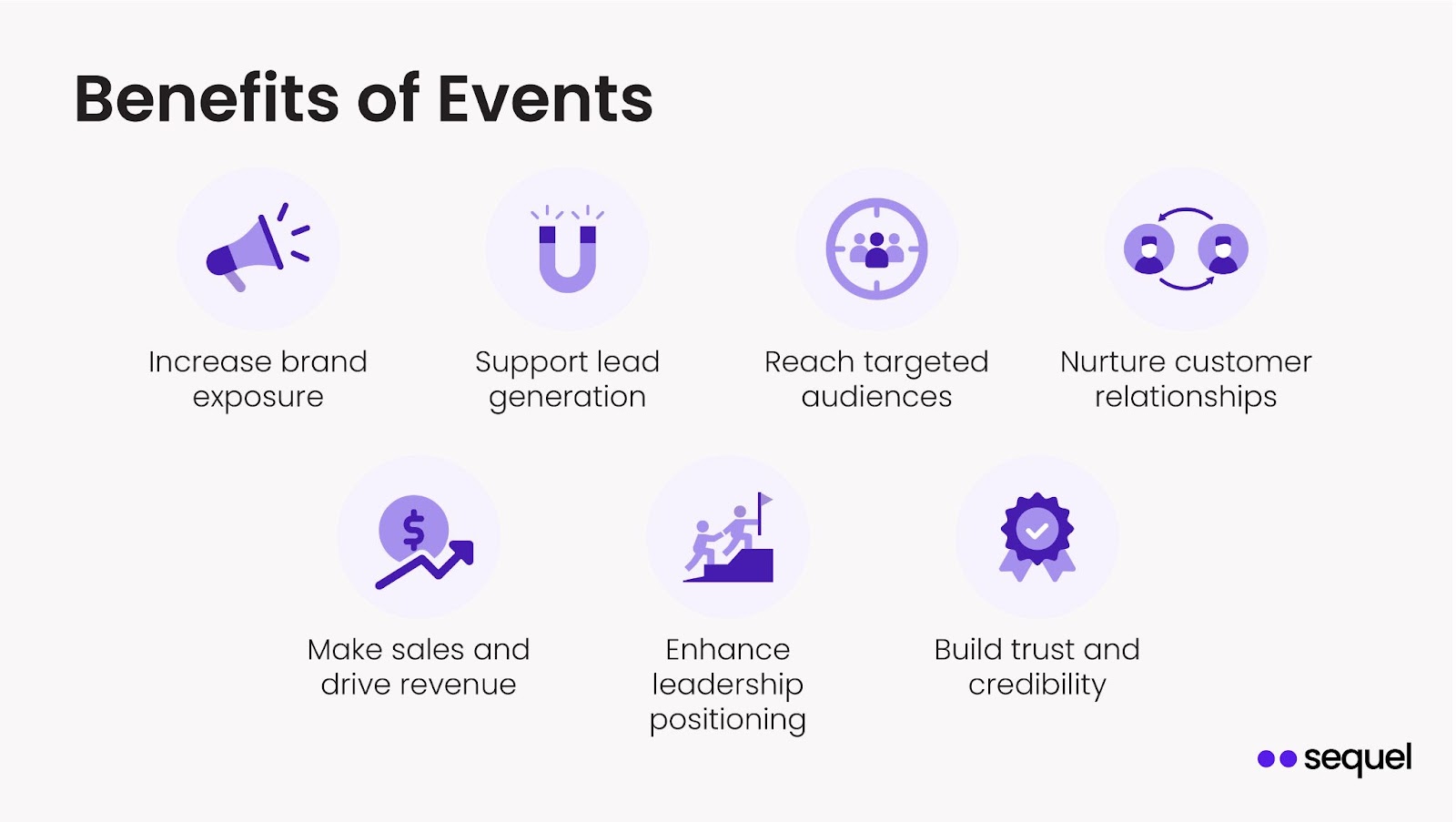
It’s easy to fall back on ‘soft’ numbers that don’t necessarily prove value–and can threaten future investment in event marketing. So how do you know if you’re maximizing your return on investment (ROI) with experiential marketing and communicate it effectively?
Here’s how to measure event success, improve your ROI, and boost your bottom line.
Measuring Event ROI: The Basics
First thing first… why should you care about event ROI?
Measuring event ROI can help you quantify your results, get leadership support, and secure your marketing budget. You can also see if your strategy is meeting event goals and delivering the desired outcomes such as generating qualified leads, building brand awareness, supporting a product launch, or driving sales.
Gathering the right metrics will give you the data and insights to fine tune your strategy and improve the results of your future events.
Event ROI represents the ratio of the net positive value you get from an event and the cost of hosting it. The basic formula, then, for calculating ROI as a percentage looks like this:
[(Total Value – Total Cost)/Total Cost] X 100
For instance, let’s say that you spend $10,000 to run an event. It generates a total business value of $25,000. That’s a $15,000 profit – or a 150% ROI (1.5X).
As with all ROI calculations, there are two ways you can improve:
- Reduce costs (lower investment)
- Increase value (higher return)
These are both viable strategies for maximizing event ROI, but it’s usually most feasible to focus on the second part–increasing value.
Let’s start there.
Increasing the Value of Events (Return)
In order to calculate the full return of your event marketing, you’ll need a strategy to tally up the total value that your event generates. This means first breaking down the ways in which events generate demonstrable results for your business.
Measuring event ROI can be challenging when your desired outcomes aren’t as tangible as dollars and cents. These include word-of-mouth, brand awareness, future sales, and customer relationships.
Consider event ROI beyond sales and revenue to understand its potential positive impacts on other marketing campaigns. For example, the improved brand image and customer relationships can help reduce customer acquisition and retention costs.
We can categorize business value from events into three main groups:
- Revenue and lead generation
- Customer retention, lifetime value, expansion, and referrals
- Brand awareness
Each one can be measured in multiple ways, and there are strategies you can implement to improve each measure and boost your overall performance.
Not all of these will be applicable to every business or every event. So be sure to evaluate how you plan to measure value before you start tracking and calculating.
Revenue & Lead Generation from Events
Ask most marketers to measure the value of their work and they’ll likely start by measuring the revenue and leads generated from the activity.
The gold standard for measuring marketing ROI is understanding its direct impact on generating pipeline and revenue. And events are regularly considered the most important way to generate MQLs.
In a 2021 study from Demand Gen Report, nearly half of surveyed B2B marketers cited webinars as the most effective strategy for generating qualified leads. One in three cited virtual events and digital experiences broadly as most effective for demand generation.
We know events work. We just need a strategy to measure their value.
4 Ways to Measure Leads Generated from Events
Measuring the leads and revenue generated by events is critical to understanding ROI. But how do you actually calculate this impact?
Let’s look at some of the ways you can accurately track and measure how your events are directly driving leads and revenue.
1. Integrate your event software with the CRM or marketing platform
To get the most accurate measurement of how an event impacts down-funnel metrics like leads and revenue, you’ll need to connect your event software to your CRM and track which leads and opportunities were generated directly from the event or attended an event as part of their customer journey.
Most event platforms and event management software should integrate with popular CRMs.
For instance, Sequel integrates directly with HubSpot, allowing you to automatically sync event activity–including both registration and attendance data–with contacts, leads, and opportunities throughout their buying journey.

Sequel also connects with Zapier, allowing you to connect the same event data to hundreds of different CRMs, setting custom fields or notes that allow you to track their performance.
Once you’ve connected your event data to the CRM, you can build custom lists and reports that show you how events are generating leads and driving revenue for your business.
Then, based on this data, you can assign a dollar value to each lead generated from your events and work backward to calculate the value of each event attendee and registration.
Don’t forget to also look at how events impact factors like sales cycle length and deal size.
2. Lead forms and new customer surveys
If it’s not feasible to integrate directly with your CRM, then you can capture self-reported attribution data directly from new leads or customers.
Usually, this means including a “How did you hear about us?” field in an inquiry form or new customer survey.
This way, when new leads come in from an event, you’ll have a simple way to handle attribution.
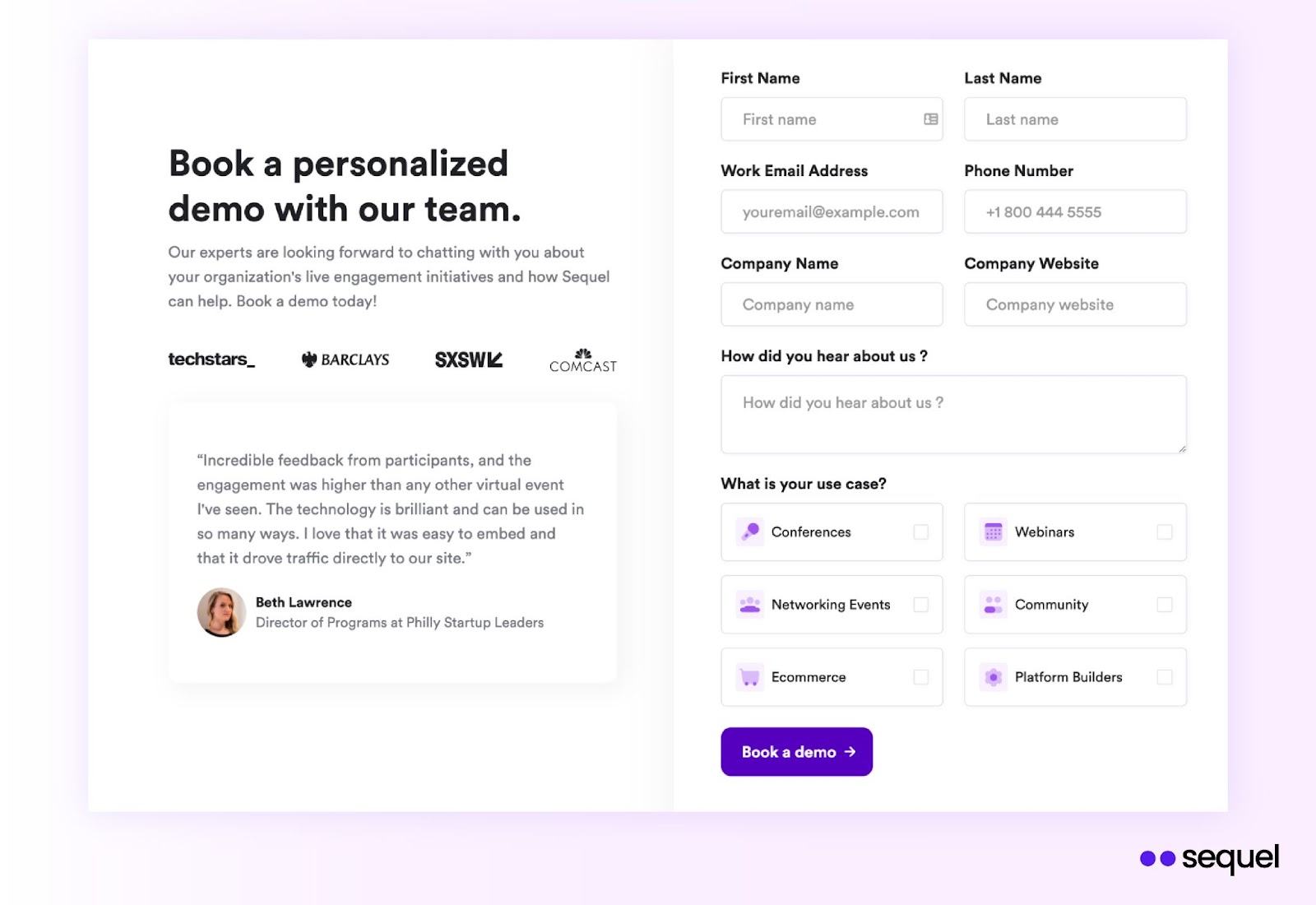
“How did you hear about us” data is notoriously imprecise. But it can at least give you a directional sense of approximately how many of your new leads or customers learned about your business or made a buying decision after attending an event.
And it’s certainly better than nothing.
3. Use PURLS or tracking URLs
Next up, you can rely on your website analytics (e.g., Google Analytics) and “PURLS” (personalized URLs) or URLs with embedded tracking information to help you attribute website leads to the events you host.
The key here is to make sure that most of the links or URLs an attendee might use will attach relevant tracking data. Meaning, add these tracking parameters to all links used in:
- Event promotion materials (including email signatures, etc)
- Event reminder materials
- URLs displayed during the event itself
As with all marketing attribution, it’s an imperfect science. But, again, some data is better than no data at all.
4. Collect information during sales, discovery, or demo calls
Finally, if you don’t have the capability to implement the above methods that might require technical resources, you can go for an analog approach.
One very simple way to correlate event marketing with revenue data is to simply have sales and customer teams ask directly about how leads learned about your company or what compelled them to reach out about more information.
This information will need to be manually logged or coded into your CRM or database. So it adds a few extra steps of manual work, but it’ll certainly give you some data to work with in a pinch.
Strategies to Increase Leads Generated from Events
Tracking leads is great.
But, tracking inevitably leads to the next question: Okay, but how do we generate even more?
Of course, the content itself–and the promotion, registration, and attendance–all have a big impact on the number of leads you’ll be able to generate from your event marketing. But there are also some specific steps and tactics you can implement to improve performance and boost your event ROI.
1. Add calls to action
The most obvious suggestion is to add specific and strategic calls to action as part of your event to prompt action from attendees.
It may seem that by simply registering for an event, everyone in attendance is already a “lead”–and we already know that event attendees do convert into leads–but having these prospects take a direct, qualifying action is what truly makes them a lead.
Make sure your event includes explicit calls to action that prompt attendees to self-qualify as a lead by making a purchase, scheduling a call, requesting more information, or signing up for another event.
2. Qualify attendees during registration
One simple trick for figuring out which event attendees are there to learn and network and which attendees are actually interested in buying?
Ask them.
Zapier does this beautifully when you register for ZapConnect. They ask you to indicate your main reason for attending. No doubt they use this data to qualify and segment registrations for future follow-up and attribution purposes.
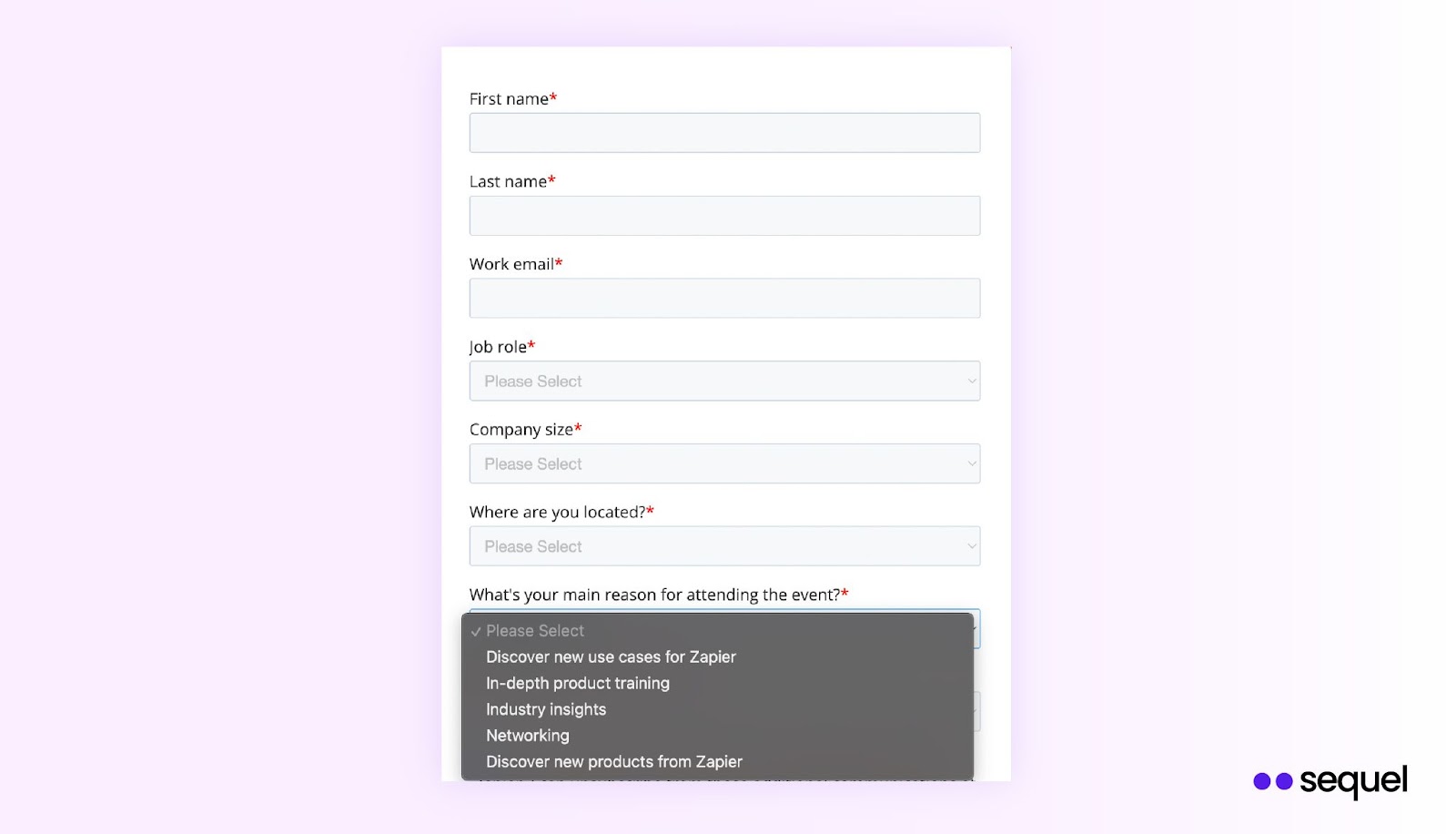
3. Repurpose live event recordings as on-demand content
Get more mileage–and higher ROI–from every event by offering it both as a live session and as an on-demand resource that can be downloaded or accessed by new leads for years to come.
By turning an event recording or recap into a gated asset, you could potentially increase lifetime ROI by 2, 5, or even 10x.
For example, Visme has a collection of nearly 100 past webinars that are now available on demand. Each one is a gated resource – collecting leads years after they originally debuted.
You can also repurpose the content of your event and turn it into different formats (e.g., blog posts and white papers) your sales teams can use to educate and build trust with prospects.
4. Charge for your event
Here’s a curveball.
Getting people to register for an event is a good start, but you maximize your ROI when they attend. Keep registrants excited and engaged between the time of sign-up and the event to increase the likelihood that they’ll attend. For example, you can use Sequel’s Pre-Registration and Access Mode to promote the event and create a community to build buzz.
Charging for the event may also improve your registration-to-attendance ratio.
Obviously, you’ll likely generate fewer registrations. But, event marketer Dan Todd has found that paid events have about a 3x attendance rate compared to free events and webinars.
It’s probably worth experimenting with a nominal registration fee to solidify the value of your event and hopefully increase attendance, leads, and ROI.
5. Follow up
Finally–don’t forget to follow up.
Many event attendees won’t self-qualify as leads right away. Use an email sequence, retargeting campaign, and other strategies to keep this audience engaged and maximize the ROI of the upfront event costs.
Customer Retention, Lifetime Value, Expansions, and Referrals
Events are undoubtedly effective at generating new leads.
But what about strengthening relationships with existing customers?
The 2021 Event Track report found that 40% of consumers say they’re more loyal to a brand after attending an event or activation. Pair that with an earlier finding from the same report: 70% of participants said they, “become regular customers,” after an experiential marketing event.
This, too, has tremendous long-term business value. Events can be a key strategy for improving customer retention, increasing lifetime value, driving revenue expansion opportunities, and generating referrals.
4 Ways to Measure Customer Retention and Incremental Revenue from Events
Let’s dig into the specific metrics and data that you can use to calculate the return on investment for your events when looking at their impact on your customer retention and incremental revenue.
1. Customer lifetime value
Once again, let’s start with the most direct and most-difficult-to-measure indicator of value.
Do events help increase the lifetime value of your existing customers?
The only way to know is to connect your events platform to your CRM or customer database and track this data over time. You’d then need to perform an analysis that compares the average CLV of all customers who attended an event versus those who didn’t.
To take it one step further, you can segment based on how many events or which specific events were attended.
2. Customer retention rate
We’ve all heard the (probably apocryphal) statistic about how much more expensive it is to acquire a new customer than to retain an existing one.
Similar to tracking CLV, you’d calculate the value by connecting event data to customer data through an integration with your CRM or database. Then segment customers based on their event engagement actions and compare retention rates (or customer lifetime).
Finally, to assign a dollar value here, calculate the net revenue generated from an increase in retention rate.
3. Product usage data
If you have host events targeted at existing customers or users, then you can measure product and feature usage as a measure of ROI.
For example, Mixpanel offers regular workshops and webinars that educate their customers about the inner workings of their product, how to maximize the value of their solution, and how to improve their analytics and product data strategy.
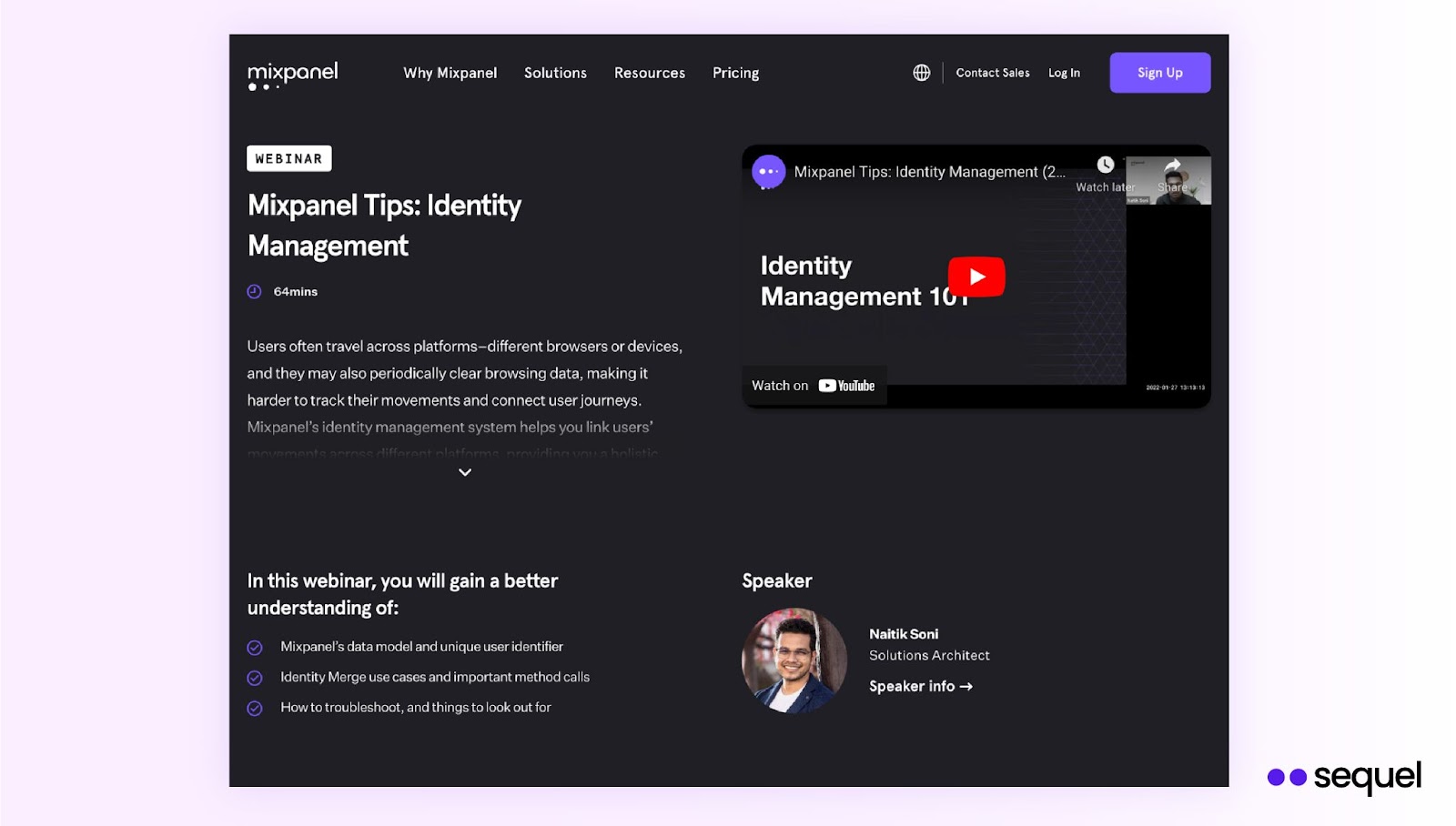
As an event marketer, it would be valuable to track how these events drive existing users to engage with the product in new ways or adopt new features and use cases.
Mixpanel is an apt example here, because their product may be helpful in tracking this data.
If you’re not able to track user or account-level usage, then you could look at product analytics prior to the event and after the event to see if there is an overall uptick.
From there, you’ll need to conduct an analysis to connect specific feature activations or product use cases with overall increased revenue or CLV. Alternatively, you can work this process in reverse to inform your event marketing strategy. Begin by identifying ‘aha moments’ that significantly impact customer retention and/or lifetime revenue and host events targeted at driving these specific actions.
4. CSAT and NPS scores
Your event experience should help you strengthen customer relationships, increase customer satisfaction, and improve customer loyalty. You can gauge its impact with changes in net promoter score (NPS) and customer satisfaction (CSAT) score.
Getting your NPS involves asking a simple question, “How likely are you to recommend our brand to a friend on a scale of 1 – 10?” (One being highly unlikely and 10 being highly likely.)
Then, subtract the percentage of people who gave you a 6 or below from the percentage who responded 8 to 10.
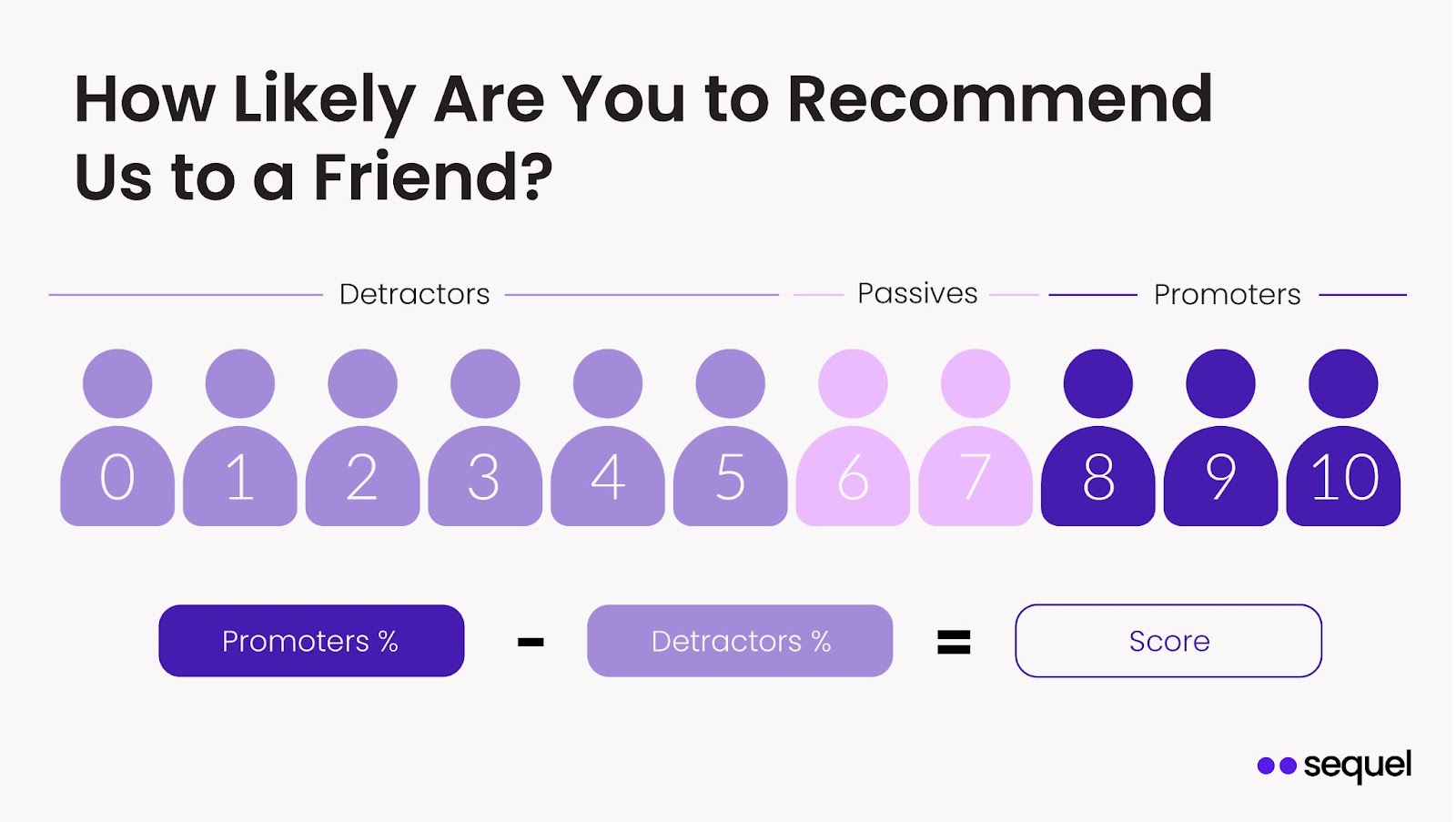
To calculate your CSAT score, ask your customers how satisfied they are with your product on a scale of 1 to 5, with 1 being very unsatisfied and 5 being very satisfied. Then, divide the number of customers who gave a 4 or 5 by the total number of respondents.
Again, the ideal scenario here would be to link CSAT or NPS with event attendance data through a CRM or customer database.
Alternatively, you could issue a customer survey before an event or series and then measure again afterward to try to measure performance.
Finally, to calculate ROI, you’ll need to compare the CLV of customers based on their satisfaction or promoter score in order to determine the business value of improving these metrics.
Strategies to Increase Customer Engagement with Events
Next, let’s discuss what tactics you can apply within your events to drive more measurable value in terms of customer retention and lifetime value.
1. Built-in networking
One key way to strengthen your relationship with existing customers, build word of mouth, and generate referrals is to incorporate networking opportunities into the event itself.
In fact, this is a big part of the draw. One study from IAEE found that 76% of attendees cited networking as their primary reason for attending an event.
We’re all familiar with the cocktail hours of yore, but in the world of virtual and hybrid events, we can capture some of that same magic using topical and role-based breakout rooms for attendees to connect and share.
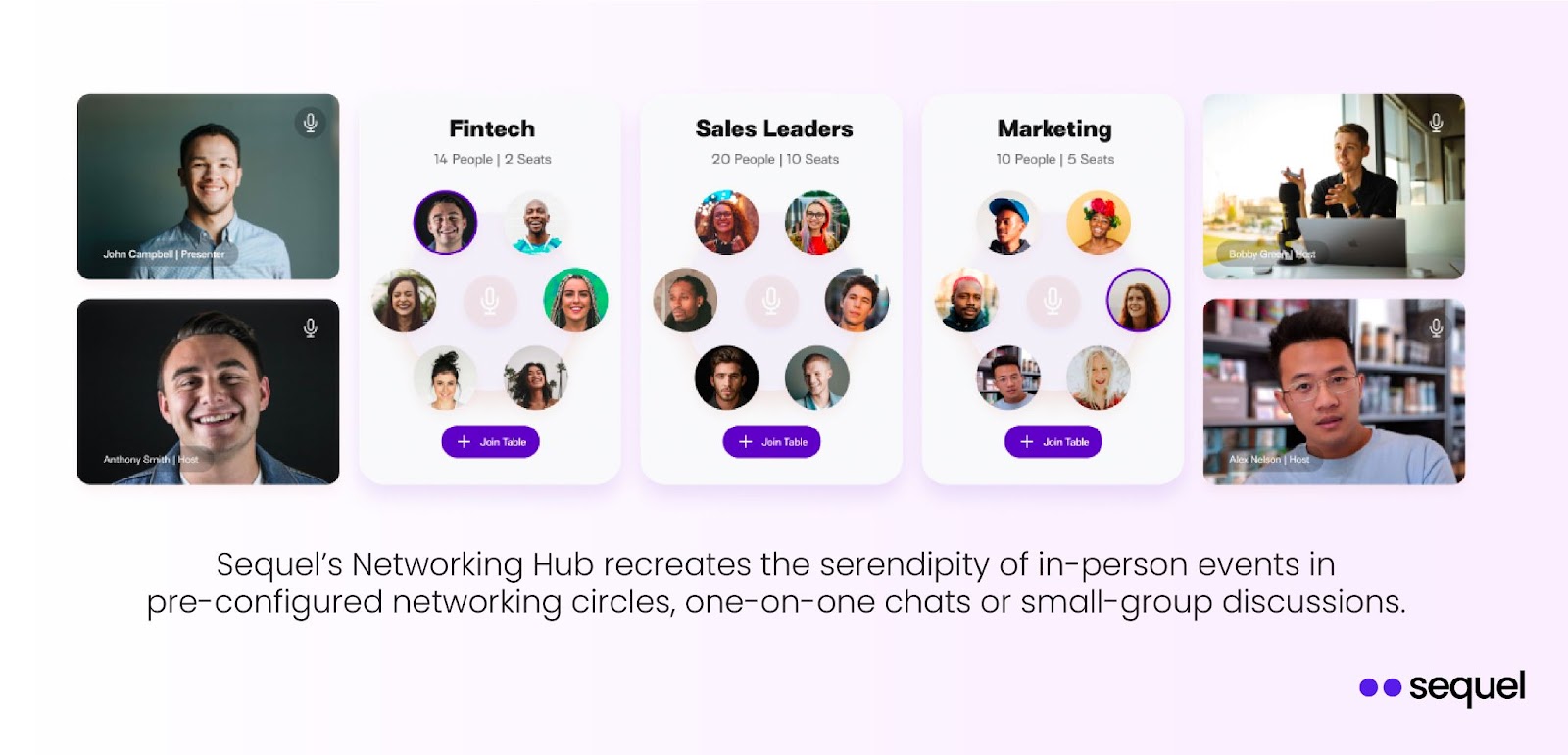
Sequel’s Networking Hub was specifically designed to create spaces for connection and conversation.
Attendees can quickly move between sessions, content, and circles without leaving the experience.
2. Co-host events with integration or service partners
Help your customers maximize their value by helping them learn about new features and ways that they can use your product or service.
Partner and integration events showcase new features, functionality, and unlocks for customers that can strengthen your relationship, drive expansions/upsells, and increase CLV.
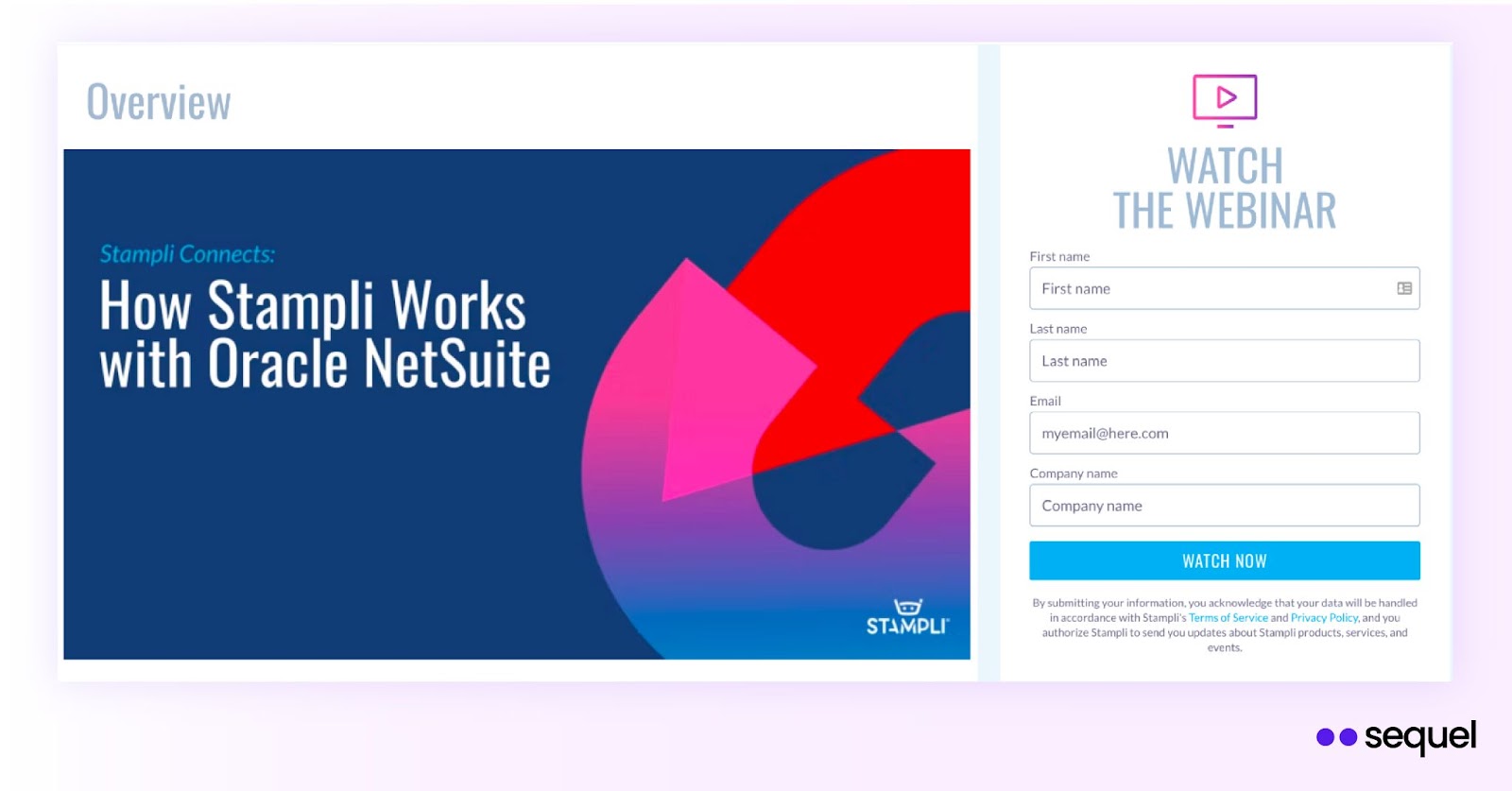
For instance, Stampli hosts a series called Stampli Connects where they showcase how their accounts payable automation software integrates with enterprise resource planning tools like Oracle NetSuite.
3. Deploy satisfaction surveys strategically
NPS and CSAT data is only useful if you’re able to collect it. And the average NPS response rate is only about 15-30%.
This means that a lot of your customers–both happy and unhappy (although probably more unhappy) are not represented in the data you collect when running an NPS survey. So you’re not able to act on a segment of customers who may be struggling to see value and most likely to churn.
What better time to maximize response rate than when customers are already engaged directly with your company during an event?
While the event itself can play a role in strengthening customer relationships, it can also serve a broader purpose as a way for you to actively engage with customers, collect data about their satisfaction, and then deploy your customer success team to act.
4. Give things away
Some may say it’s fickle, but giving things away works.
One extremely low-cost way to improve customer satisfaction and engagement is to offer merchandise, prizes, and other small rewards for those who attend. This can increase
Only 30% of event marketers say they use giveaways. But, according to data from the Promotional Products Association, a whopping 85% of people say these items have an impact on their purchase decisions.
This can flow into brand awareness, too, as customers share photos of themselves with the gifts or merchandise they’ve received and help grow word of mouth.

Testbox has used branded coffee mugs as part of a recent campaign, generating thousands of free impressions on social media as their customers share photos of the merchandise they received.
Brand Awareness
As marketers, we’d all love to connect the dots directly from our work to revenue.
But events generate more value than just what we can measure directly.
A bit of a catch-all category, brand awareness is an attempt to quantify the intangible benefits of our marketing efforts. It’s about building visibility, trust, and long-term value.
There are many ways to measure the impact events have on our overall marketing presence.
6 Ways to Measure Brand Awareness Generated by Events
1. Event registrations (and attendance)
Event registration is its own form of building brand awareness.
Through all of your marketing efforts, you should focus on driving sign ups for the event and collecting information about attendees.
Benchmark the number of registrations that you receive for each event and measure how they are growing over time. Ideally, couple this with a measure of the number or percentage of registrations who attend.
Once you’re able to calculate a trend in event growth over time, you can use this number to calculate the marginal value of each event based on the “hard” metrics we discussed in the above two sections.
2. Website traffic
One of the reasons customers love hosting events with Sequel is that the entire event experience can live on your own website. This means you’ll see an increase in traffic and SEO lift with each event.
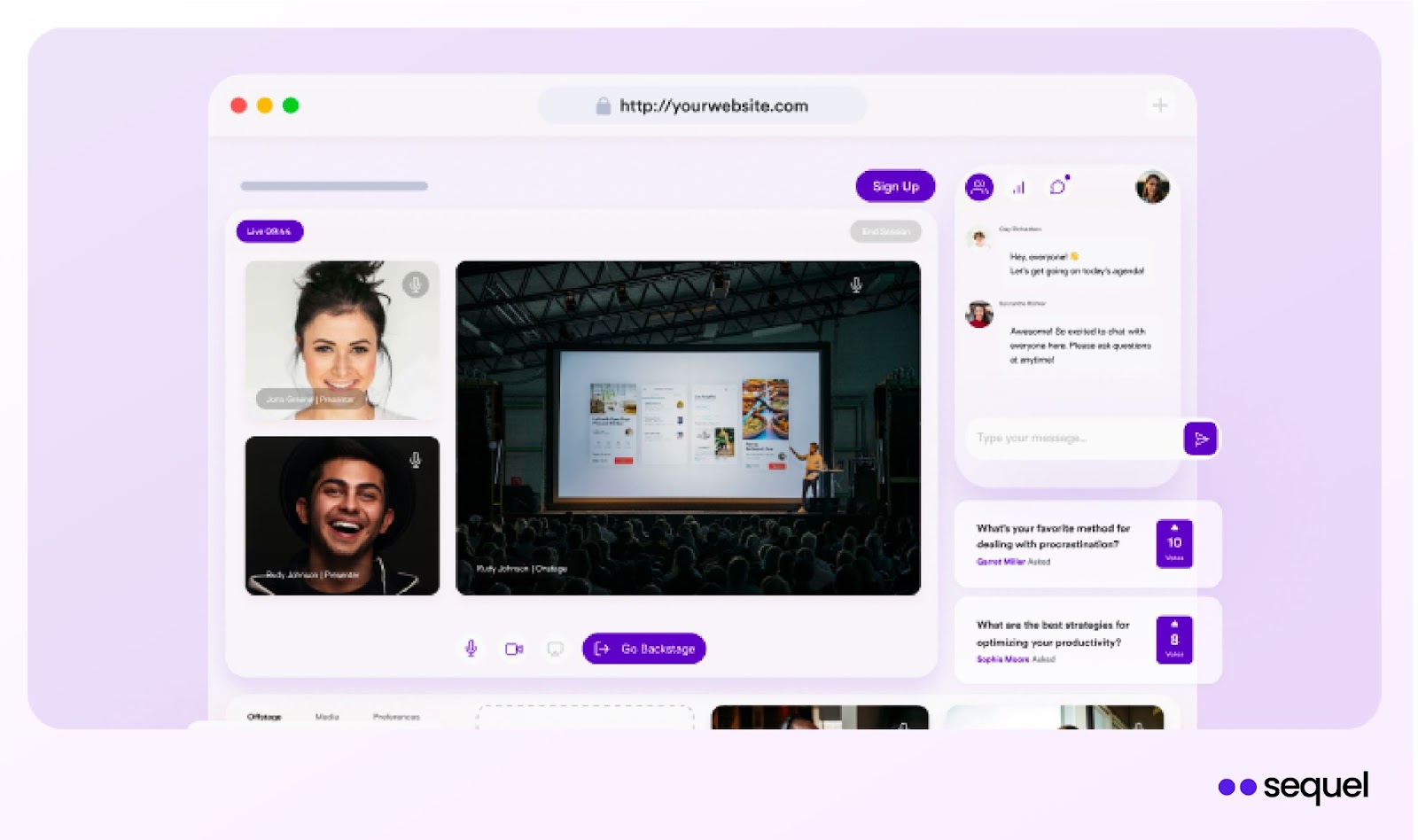
When calculating event ROI, you can factor in this increased traffic.
Using Google Analytics or other analytics platforms, you can measure how that increase in website traffic correlates with an uptick in valuable actions being taken on the site like form fills and key page views.
Ideally, you would assign a monetary value to each of these actions to estimate the business value of the interaction and the additional traffic you’re generating.
3. Event engagement time
Another measure of engagement that comes directly from the event itself is the amount of time attendees spend actually watching or participating in the event.
Depending on which platforms or technology you’re using to host your event, you should have some way to track and measure the total number of minutes or hours that your attendees spent engaged with the experience.
For instance, Sequel’s dashboard provides both lifetime event engagement statistics and data on each individual event.
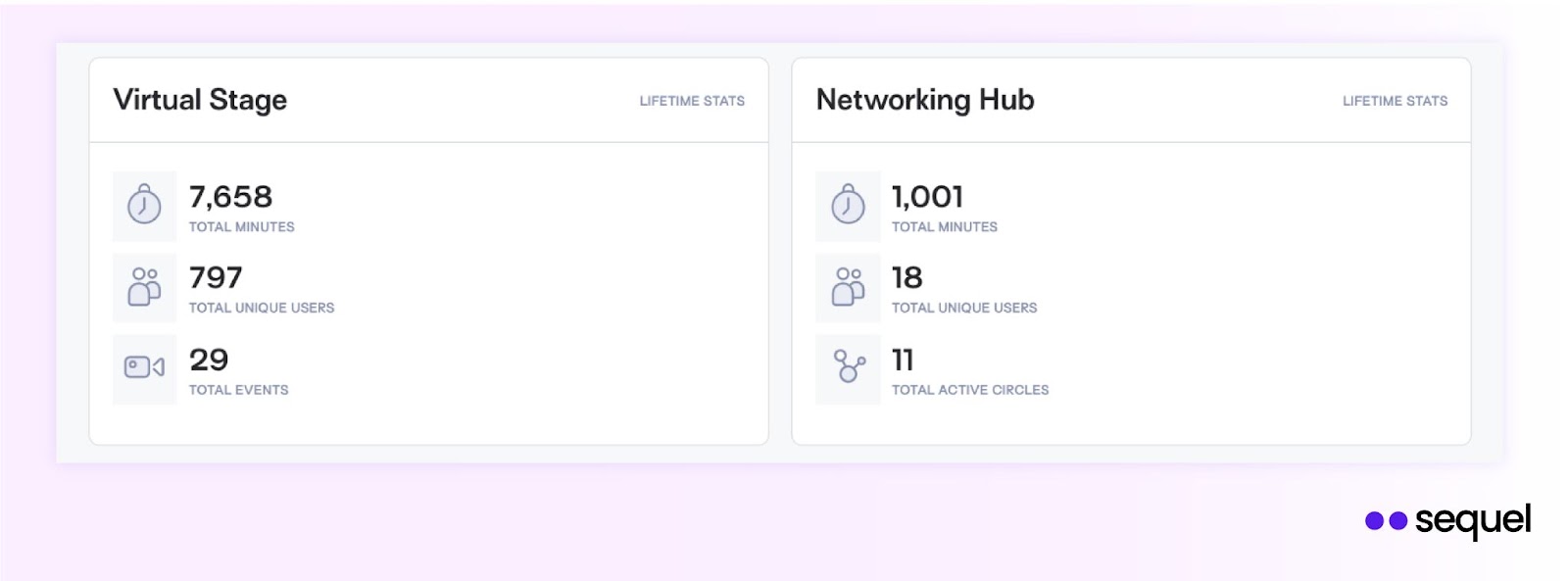
4. Social media reach and impressions
Social media follows, mentions, hashtags, and conversations offer important top-of-funnel metrics to show how well an event promotes your brand’s message and delivers a memorable experience that people want to share with their networks.
Skift found that more than 1 in 3 event marketers measure social media engagement as a primary indicator of event success.
You can quantify the impact of events by measuring stats like:
- Shares
- Reach
- Impressions
- Engagement (Reactions and comments)
- Followers and Likes
Benchmark these metrics before, during, and after the event.
If you have marketing and conversion data set up in your website analytics and tracking set up to attribute traffic to the various social media channels, then you should be able to work backward to estimate the incremental value of generating additional follows, likes, shares, and other metrics.
5. Media mentions
Besides social media, consider how the event is reported or featured on TV, radio, online publications, and other media outlets. These appearances can help you build brand awareness and reach new audiences.
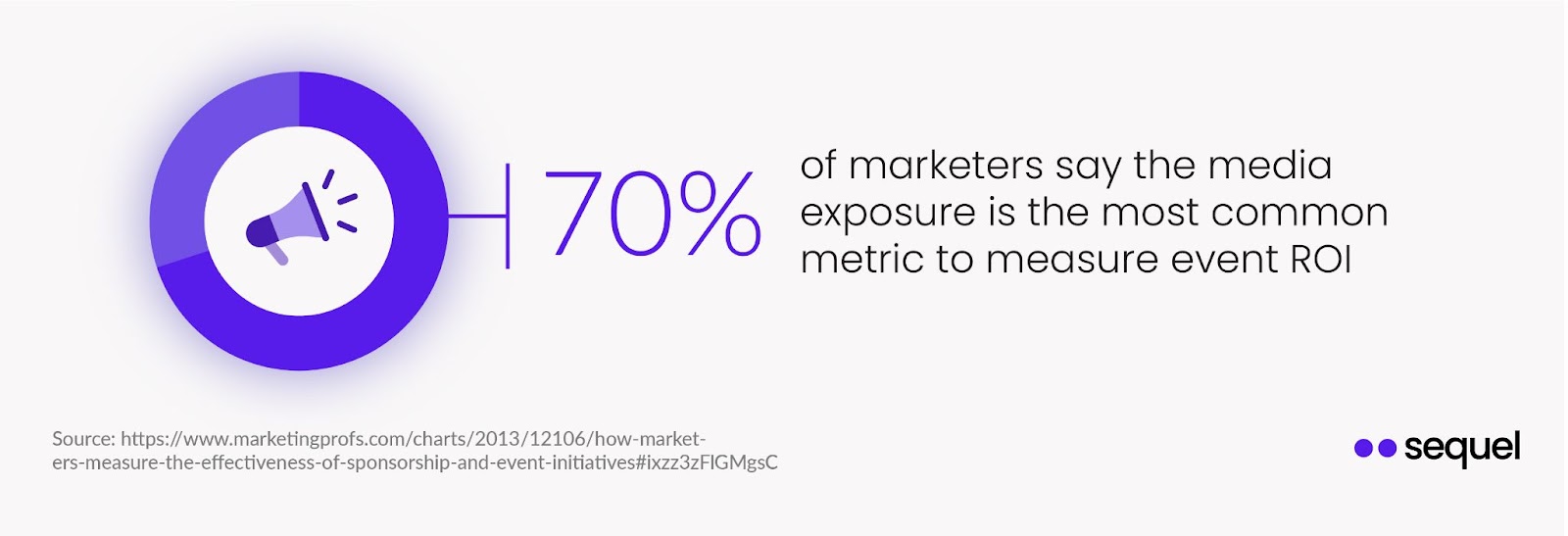
Here are some common methods for measuring media coverage:
- Mentions: Measure the number of times online and offline publications mention your event or brand. Besides quantity, also consider the quality of the publication and how prominently your brand is positioned in the content.
- Sentiment analytics: Collect and analyze data on the way media outlets portray the event to see how it affects people’s attitudes, emotions, and opinions toward your brand. An AI tool with natural language processing (NLP) capabilities can handle large amounts of text data and for timely insights.
- Share of voice (SOV): Compare the number of mentions of your event by media outlets with that of your entire competitive set. The metric shows you how likely your audience will notice your brand.
- Engagement volume: Track comments, link clicks, shares, etc., to see how the audience engages with your media mentions and gauge if the messaging resonates with the right target market.
Strategies to Drive More Brand Awareness with Events
To attract more prospects, invite thought leaders and influencers in your industry as guest speakers and ask them to share the event with their followers.
1. Partner with influencers to increase reach
Remember the Fyre Festival? Horrible event, excellent promotion. The organizers of Fyre Festival understood two very important things about their audience:
- They aspired to live a jet-set lifestyle
- They were frequently on Instagram
Knowing those two things, the organizers put together a simple yet highly effective strategy—pay social media influencers to post an orange square on their Instagram feed with the hashtag #FyreFestival and the event website. The orange square stood out in the sea of photos in the feed, the names of celebrities indicated the prestige of the event, and the lack of additional information aroused intrigue.
Are we advising you to put on Fyre Fest 2.0 or hire Kylie Jenner to promote your event? Absolutely not! But engaging influencers in your niche in your promotional efforts is a great way to set the tone for your event.
2. Invite an influential guest or host
Don’t underestimate the power of your choice for keynote speaker. Not everyone can afford to hire Gary Vaynerchuck for their event, but you can find somebody within your budget that will have an outsized effect on your promotional efforts.
To do this, look through events from your industry and adjacent industries. Look at their list of speakers and cross-reference each name with their social media following, email list, and overall engagement with their audience. Choose a speaker that excels at promoting their speaking schedule and maintains and engaged following on social media and you’ll likely draw from their existing audience.
3. Prompt attendees to share/engage on social media
Every event should have an official hashtag so attendees can communicate with one another–and this should be widely promoted–but you don’t have to stop there. You can create leaderboards for your attendees based on who has tween the most, contests from your brand, have presenters work social media activities into their presentations, and conduct giveaways for those who engage with your timeline.
Adding it Together: Total Event Return
Once we’ve worked out how we want to measure and attribute value to the event itself, it’s time to calculate a total value from our event. This will be the number that we use to calculate the total event ROI.
Let’s say, for instance, that we run an event and we calculate the following measures of value:
- 2% lead conversion rate ($2,000 per lead)
- 20% increase in pricing page views ($50 assigned value)
- 500 new social media followers ($2 each)
If our event has 1,000 attendees and our baseline number of pricing page views is 1,000 per week, then our total value is:
- $40,000 in leads
- $10,000 in website traffic
- $1,000 in social reach
The grand total for the event: $51,000.
Now let’s cover the costs.
Lowering Costs of Events (Reducing Investment)
Before we can calculate ROI, we need to add up how much we spent on producing, hosting, and running the event.
Add together all associated costs:
- Total hours spent planning, promoting, and running the event
- Marketing, advertising, and promotion expenses
- Paid speakers or hosts
- Software and technology
In the case of our above example, let’s assume that the all-in cost to produce and host this event was $15,000.
Keep in mind that although the main way to improve event ROI is to increase the value that the events generate, you can also look for ways to reduce your investment.
Some tactics include:
- Brand partnerships – Partner with another company to co-host an event and split the costs of production.
- Event swaps – Offer to host or present at someone else’s event in lieu of paying for speakers or hosts
- Use organic promotion – Cut your ad spend by focusing on generating social/organic reach and WOM
- Streamlined tech stack – Simplify your software stack to minimize spend
Calculating Your Final Event ROI
Now we’re ready to calculate the final ROI of the example event from above.
Remember our event cost $15,000 and generated $51,000 in estimated business value.
We’ll use our formula:
ROI % = [(Total Value – Total Cost)/Total Cost] X 100
Plug in this numbers:
ROI % = [($51,000 – $15,000)/$15,000] X 100
This gives us a 240% ROI – or a 2.4X or 2.4:1 return.
This, of course, leads to the inevitable question: Is this a good ROI for an event? Or should we be looking for ways to improve.
Let’s look at some data to answer that.
Event ROI Benchmarks: What Should I Expect?
Any time we’re talking about measuring marketing effectiveness, there’s a disclaimer necessary.
Benchmarks are helpful heuristics for understanding our performance – but unless your business is exactly the same as someone else’s, you shouldn’t expect the exact same results.
Disclaimer out of the way. Now, what’s a good event ROI?
According to an EventTrack report, 48% of brands realize an ROI between 300% and 500%, while 44% generate an average return of 300%. That leaves ~8% unaccounted for.
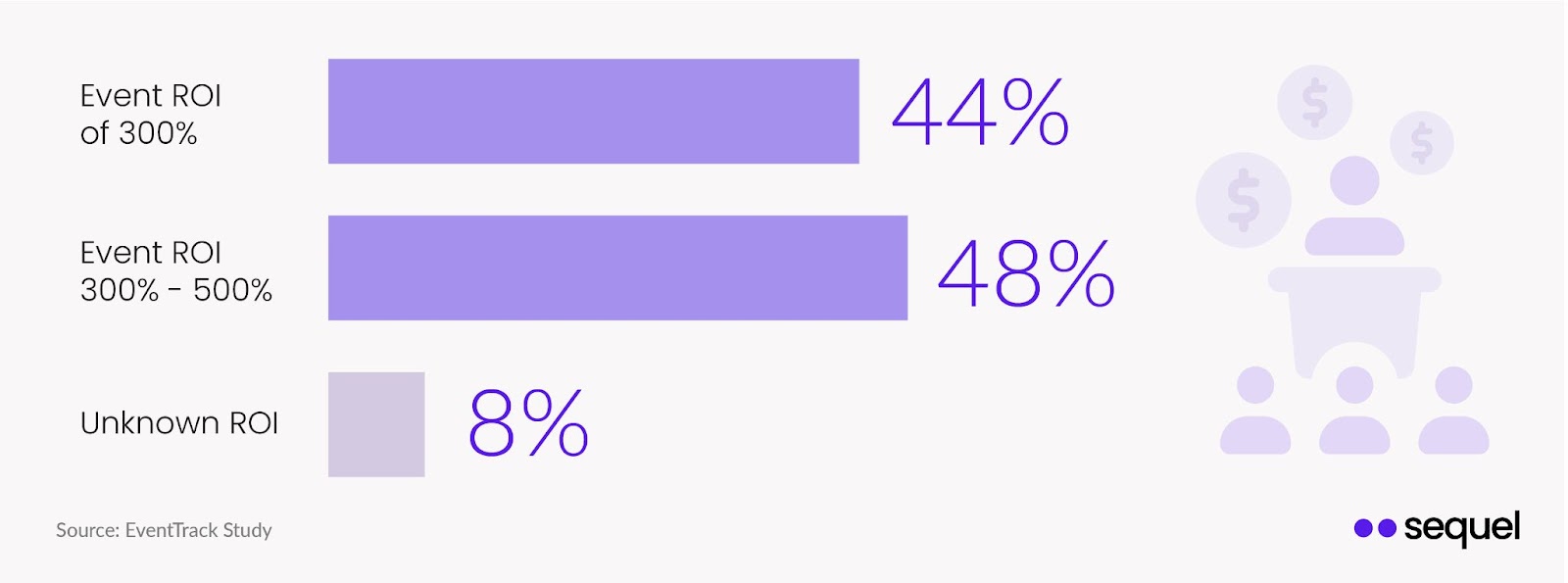
So, how did our event stack up? It seems to be a bit below the benchmarks. But, keep in mind that this data is a bit outdated. And what really matters is our event ROI over time. This gives us a baseline and our goal now should be to improve on this performance in subsequent events.
Maximize Your Event ROI With the Right Technology
The right event technology can help you streamline event planning, get in front of more people, deliver a seamless brand experience, drive engagement, and continue the conversation after the event.
Not to mention, easy-to-use technologies that consolidate various features and integrate with your website can help you deliver a seamless brand experience while reducing production costs.
Sequel is a revolutionary virtual and hybrid event solution that helps you engage a virtual audience and extend the value of your event through various digital channels—e.g., repurposing the content as webinars. It offers features such as reactions, live polls, Q&A, and networking hubs to encourage interactions, build community, and augment the event experience.
You can embed Sequel to your website without coding skills to streamline production and deliver an on-brand experience while eliminating technical hiccups that often happen when you cobble together different tools.
Our highly modular and scalable solution can support brands and events of any size—we can handle up to 2 million participants! Whether you’re a startup or a large enterprise, we’ve got you covered.
See how we can help you improve your next event’s ROI.